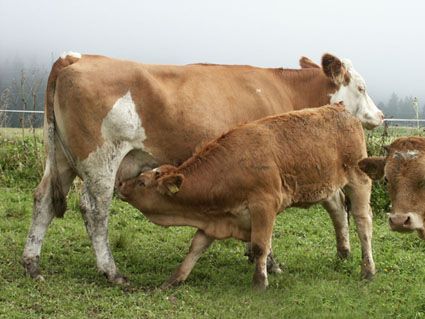New challenges
However, the abolition of the suckler cow premium presented suckler cow farmers with new challenges. In order to achieve a positive economic outcome, the resources available on the farm, such as the feed base, animal genetics and marketing opportunities, coupled with good management, must be used in a very targeted manner. There is still a great need for optimization in many companies. Since around two thirds of the annual revenue comes from the sale of the calf, it should be possible to sell one calf per cow per year! The mother cow itself plays a crucial role. Problem-free and long-lasting suckler cows with good functional characteristics (udders, claws, maternal instinct…) are the basis for success. They are characterized by good fertility and longevity and should also have correct feet and legs and a good pelvis length in order to calve easily. And last but not least, they should give a lot of milk so that the calves can achieve good growth even without concentrated feed. Such mother cows can certainly come from pure breeding (possibly also genetic preservation of local breeds), but could also be obtained through targeted crosses. Due to the heterosis effect, the performance and vitality of mixed breeds or hybrids is higher than that of pure-blooded ancestors and the effect is greater the more different the original genetics of the ancestors are.
Interesting findings
F1 cross-breed cows (crossing a dairy cow with a meat bull) are successfully used in many suckler cow production herds around the world Such crossings would be particularly useful in grassland areas, where suckler cows are kept in addition to dairy cattle. As part of cooperation, dairy farmers could breed less valuable cows with a meat breed animal, as is already the case in some cases. However, this meat breed animal must not come from an intensive fattening breed such as white-blue Belgians or Charolais, as these calves are not suitable for extensive fattening on pasture. Rather, the crossing partner should come from a breed that is precocious and delivers good growth performance and satisfactory carcasses even under extensive conditions - such as: B. Aberdeen Angus. The suckler cow farmer takes all cross-bred calves from his cooperation partner, the males are castrated and kept on the pasture as oxen. The females are passable mother cows and can also be fattened on pasture when there is no need for replacement - a win-win situation for both! There are hardly any documents or research results available on this topic. For this reason, the present project was started at the HBLFA Raumberg-Gumpenstein in 2016 and some new and interesting findings for practice can already be derived from the initial results.
Conclusion
It can already be seen that the use of F1 cross-bred animals (dairy breed (HF, BS) x Angus) as suckler cows seems to represent a sensible alternative to purebred suckler cows from dairy farming. Such crossbred animals could be obtained through cooperation between dairy and suckler cow farmers, which would ultimately have a positive effect on the economic situation of both cooperation partners. The final results will be presented in 2021.







